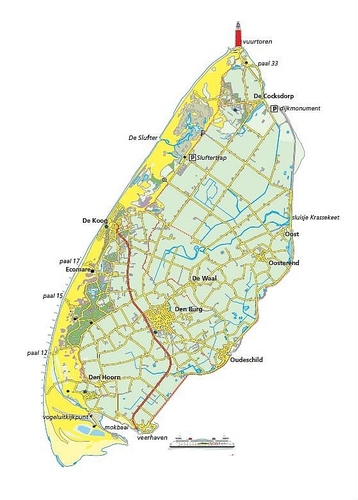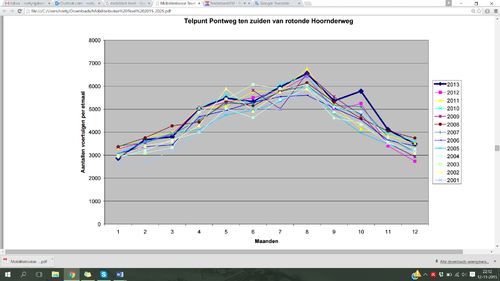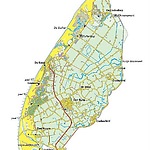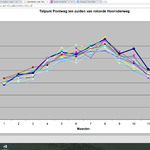1.2 Mobility in Texel as a socio-technical system
The mobility in Texel can be understood as a system that combines people and institutions together with transport technology and infrastructure. Most people go to the Island with the ferry from Den Helder (mainland) to het Horntje (Texel). To travel around Texel can be done by foot, bike, car or public transport. The island has around 900.000 tourists from in and outside the Netherlands every year. This makes Texel in the summer more crowded than in the winter.
A good mobility is important for the viability and attractiveness of Texel as a tourist destination. The mobility situation on the island is special because of the many tourists who visit the island. They provide peak periods in the season and on weekends. Therefore, preparing an effective mobility system for these periods is an important factor to take into consideration. Texel wants to be a hospitable island where guests move without experiencing a sense of bustle and stress. The people of Texel want to give the guests an experience of peace and space. For the Texelaars (people from Texel) it is a matter of great importance not to encounter no obstacles in their mobility. Especially in the high season Texelaars have to minimize any inconvenient experience by the increase in population and traffic[1].
Developments on mobility coming years
In the mobility vision of Texel 2015-2025 are described different possible developments in the coming years. Below they are briefly set out:
1. The use of cars in the Netherlands continues to increase until the year 2020 due to the increase in the number of households and social change. Older people remain healthy longer, be more prosperous and strive for independence and comfort. The so-called 'rush hour family' combines many tasks and therefore increasingly chooses the car.
2. The composition of the population changes, the number of older people (with private transport, wanderlust and active) increases.
3. The public transport in rural areas is under pressure.
4. The Netherlands remains a country of cyclists but the bicycle traffic is not expected to grow.
5. The number of transported cars and persons to Texel will increase considerably.
6. Due to the increase of the car use, the pressure on parking lots will increase parking[2].
Tourists in Texel
As mentioned before, the tourist are quite important for Texel. The VVV of Texel (tourist information) is doing a survey every year on the visitors to Texel. The main part of the visitors (30%) are married / cohabiting with children living at home. More than a third, 29%, has no children. Approximately 22% are between 45-54 years old, followed by the 55-64 age group (around 18%). They have an average or above median income, between € 20,000 and € 60,000. The number of young visitors decreases. Most visitors are from North Holland, followed by South Holland and Gelderland. Key reasons to visit is nature / landscape, beach, rest and walking / cycling. Accessibility is becoming increasingly important as a reason to come to Texel. Based on the data of the VVV of Texel it can be expected that the number of visitors who come to Texel by car will increase[3].
The accessibility of Texel
The ferry service between Den Helder and Texel is the most important connection to the island. Substantially all of the people and goods to and from the island are transport with the ferry. TESO maintains this and the service runs between 06:00 and 21:30. It appears that there is no need to change the accessibility of TESO. There is satisfaction about the current balance between the accessibility of Texel and rest.
TESO (the ferry company) has commissioned a study in 2009 (DTV Consultants) for the development of the transport to Texel in the coming decades. Not all of these issues are equally important for Texel, but for the development of transport until 2040 it is worth to know that:
1. The tourism on Texel will increase further (growth of German tourists keeps on / Wadden Sea as World Heritage presumably attracts new tourists / Texel is by nature, tranquillity and space-image are less sensitive to competition / Dutch people continue coming, partly because vacations close to home are more popular again);
2. The increasing individualization and motorization makes the transport growing faster than the population growth;
3. Leisure time becomes more intensive, more individualistic and more commercial;
4. The Netherlands is aging, but the elderly of the future are more active, richer and more mobile. They have their own transport, are traveling more eager and want more luxury and comfort;
5. The indigenous population of the Netherlands, the traditional visitors of Texel, is not growing and that non-Western immigrants ignore Texel;
6. There will be an economic growth (higher Gross Domestic Product, higher income per capita);
7. The car remains the dominant mode of transport, but it will be more intelligent (more driving tasks are automated) and environmentally friendly (smaller, more economical, electric);
8. The threat of climate change will not manifest before 2040, on the condition that
CO2 reduction policy is successful.
Texel needs to take into account an increase of 2.2 million vehicles and 4.5 million people in 2040[4].
On Texel there is one provincial road (N501) present: between the ferry and De Koog. This road is the main artery of the Texel road network (see red line on the image below). The access roads to the different villages are connected to this road and ensure a good connection.
Image 1. Map of Texel with in red the main road (N501) [5]
The number of cars on the island is measured at different places. At the measurement point Pontweg South (the gateway to Texel) the number of passing cars is tracked for a long time. The following chart shows the results of these measurements.
Image 2. Chart of number of vehicles per day at different months from 2001 until 2013 [6]
It is clear that the number of vehicles increases significantly during the summer season, the most crowded period of the year. Besides this, it can be concluded that the traffic growth on the island, in particular, has occurred around within the summer season. The data shows a slight traffic growth, through the years. Consequently, it is expected that the parking pressure by this increase also will increase proportionally.
Mobility on the island
Texel is seen as an island made for cycling, while the car is not excluded. The bicycle path network will be expanded with new bike lanes. The bike paths will be wider and are better maintained. In the centres of the villages and near the beach are good and sufficient parking places for bicycles.
Texel is also taking in account the disabled people. As custom bikes are rented to people with disabilities and there are (electrical) beach wheelchairs available at various beach pavilions. The busses are comfortable and accessible to people with disabilities.
The road network is well maintained and unsafe intersections are converted to roundabouts. The roads are designed according to the principle of Shared Space: safe for pedestrians, cyclists and motorists. There will be suitable parking lots at the edges of the villages. Cars are at the edge of the villages referred to these car parks.
Texel wants her guests to de-stress, even when it comes to paid parking. Some years ago is as a first step entered to the Texel Vignette. For only € 15 per year, the guest can park anywhere. One can also choose to pay an hourly rate using the parking meter. The hourly rate is € 2.50. Paid parking is applies for parts of Den Burg (environmental center), De Koog (environmental center) and
Oudeschild (harbor). It is not clear to everyone what should and should not be paid. The aim is not to increase the parking fees for Texel Vignette and parking meter, so they want to keep it at a low price level.
[1] Based on: Mobiliteitsvisie Texel 2015 – 2025, Duurzame mobiliteit op Texel, june 2015, gemeente Texel
[2] Based on: Mobiliteitsvisie Texel 2015 – 2025, Duurzame mobiliteit op Texel, june 2015, gemeente Texel
[3] Based on: Mobiliteitsvisie Texel 2015 – 2025, Duurzame mobiliteit op Texel, june 2015, gemeente Texel
[4] Based on: Mobiliteitsvisie Texel 2015 – 2025, Duurzame mobiliteit op Texel, june 2015, gemeente Texel
[5]http://www.bunkerpictures.nl/datasheets/holland/datasheet-texel.html (retrieved 15 November 2015)
[6] Based on: Mobiliteitsvisie Texel 2015 – 2025, Duurzame mobiliteit op Texel, june 2015, gemeente Texel



